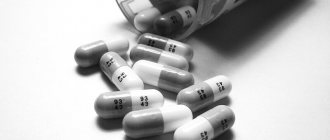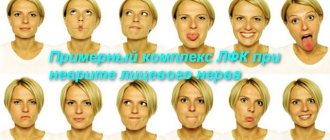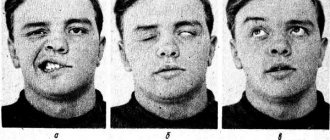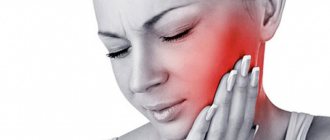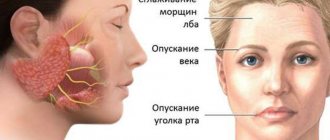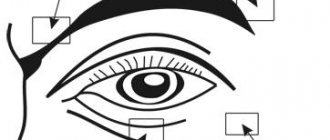- Location and functions of the facial nerve
- Causes
- Symptoms
- Diagnostics
- Treatment
- Otogenic neuritis of the facial nerve
- Folk remedies
- Possible complications
- Prevention
Pathology of the facial nerve is registered annually in 2–3 people out of 10 thousand people. It occurs due to various reasons, the nature of which largely determines the treatment of facial neuritis. Taking into account the anatomical connection of this formation and the ENT organs, with neuritis of the facial nerve the patient needs to consult not only a neurologist, but also an ENT doctor.
Location and functions of the facial nerve
The facial nerve controls muscle movements in this anatomical region. This gives a person the opportunity to smile, express emotions with facial expressions, cry, and wink. Facial neuritis can lead to severe physical disability that is poorly tolerated psychologically. Although in most cases the symptoms of the disease gradually disappear, this requires long-term rehabilitation.
The facial nerve is the seventh of 12 paired cranial nerves. Each person has 2 facial nerves, corresponding to the right and left halves of the face. This nerve is adjacent to the eighth nerve, the auditory nerve, and passes through the structures of the middle ear, the mastoid process, and the parotid salivary gland, where it splits into many small branches.
Residual stage
Starting from the 4th month of the development of the disease, with proper and regular training, a residual period begins. This is the time when there are clear improvements in the facial abilities of the affected half of the face, but residual symptoms are still preserved. The duration of the period is 2-3 months.
For good dynamics and consolidation of the results obtained, it is important to continue performing exercises from the main stage of training. The main task at this time is to increase muscle activity so that facial symmetry is restored.
Compliance with all medical recommendations, a combination of therapeutic exercises and massage will be the key to sustainable recovery of facial muscles.
Causes
Facial neuritis occurs under the influence of the following etiological factors:
- in 15% of patients this is damage to the branches of the nerve during surgical interventions on the middle ear, mastoid process, and also associated with otitis media and other lesions of the hearing organ, for example, cholesteatoma;
- in rare cases, the disease is caused by infection - herpes virus (Hunt syndrome), mumps, polio, influenza, as well as Lyme disease, transmitted through tick bites;
- in 75% of cases, the cause of neuritis of the facial nerve cannot be determined; in this case, they speak of Bell's palsy, which worsens after hypothermia and colds.
Other causes include head trauma, surgery on the salivary gland, and removal of an acoustic neuroma.
Principles and techniques of facial massage for neuritis
The main effect of acupressure is based on the principle of reflexology. Strong pressure on bioactive points activates individual areas of the cerebral cortex that are involved in the innervation of the face.
Another component of treatment is the physiotherapeutic effect. Massage improves the tone of facial muscles, improves their motor activity, activates blood circulation, metabolism, and nerve restoration.
Tibetan medicine classifies facial neuritis as a cold disease of the Rlung (Wind) system. Warming procedures are useful for such diseases. Acupressure, by increasing blood circulation, creates such a warming effect. This helps not only to remove tension or spasms in the facial muscles, but also to improve their contractile activity. Thanks to this, the restoration of facial expressions is achieved, persistent paralysis and facial distortion are prevented.
Symptoms
Manifestations of the disease occur acutely, within a few hours, for a maximum of 3 days. The gradual appearance of signs is most typical of compression of the nerve by a tumor growing from the surrounding tissue.
Depending on the severity, neuritis of the facial nerve is accompanied by the following symptoms:
- movements of the facial muscles are weakened, up to barely noticeable, disruption of conjugate contractions of symmetrical areas of the face;
- facial asymmetry, even disfiguring;
- difficulty closing the eyes; in severe cases, the palpebral fissures do not close completely;
- disorders of swallowing, chewing, speech;
- when the disease is complicated by keratitis, vision loss gradually develops;
- taste disturbance, weakening or strengthening of sound sensations;
- lacrimation;
- with simultaneous damage to the trigeminal nerve - severe pain in the facial area.
Signs of intoxication and fever are uncharacteristic and usually occur due to the infectious nature of neuritis of the facial nerve.
Characteristics of the disease
Facial neuritis is a disease that causes inflammation and damage to the cranial nerves, the trigeminal nerve, and its processes.
When sick, a person cannot control emotions and facial expressions, and has difficulty chewing food. The facial nerve is located in the canals of the facial bones and suffers from even a slight inflammatory process, as a result of which it is compressed. Under such circumstances, oxygen deprivation leads to the appearance of external symptoms. If the nerve trunk is damaged, motor disturbances and changes in sensitivity may occur. In the most severe situations, neuritis becomes a factor in the development of paralysis. According to statistics, almost all patients (regardless of age and gender - men and women equally) most often experience problems with facial expressions on one side of the face, and in some people - on both sides. The peak of the disease is diagnosed in the winter season, when the cold comes.
The peculiarity of the treatment of facial neuritis is its protracted nature; in an inpatient setting, the patient is treated for up to 30 days, the period of complete rehabilitation of the brain and central nervous system is up to six months. In at least 5% of neurologist's clients, the activity of the facial muscles cannot be restored as a result of treatment. This happens in people whose disease is caused by malignant neoplasms (oncology) of the brain or brain injury. Determining the form of severity of neurological damage in which the disease develops depends on the degree of damage to the nerve trunk and how timely the treatment process is started.
Diagnostics
Treatment of facial nerve neuritis is prescribed after an examination, which includes:
- general blood and urine tests, blood glucose levels;
- if the infectious nature of the disease is suspected (Lyme disease, HIV infection, syphilis and others) - appropriate serological tests;
- if sarcoidosis or brucellosis is suspected, chest X-ray;
- in the case of a prolonged course (more than 3 weeks), if damage to the brain stem or cerebellopontine angle is suspected, MRI is prescribed, and if the pathological process is localized in the area of the temporal bone, computed tomography is more informative;
- Electroneuromyography is used to assess the effectiveness of treatment;
- If a nerve tissue infection is suspected, a lumbar puncture and cerebrospinal fluid examination are performed.
If the patient has already been diagnosed with ear diseases, or has discharge from the ear canal or hearing loss, he should definitely consult an ENT doctor.
Facial neuritis is differentiated from Lyme disease, Ramsay Hunt syndrome, Melkersson-Rosenthal syndrome.
Can acupressure replace acupuncture for facial neuritis?
Often, patients ask the doctor to limit themselves to massage, explaining that they are afraid of acupuncture. But despite all the effectiveness of acupressure, it cannot replace acupuncture.
1. Only with the help of acupuncture can you stimulate the production of neurotransmitters - substances necessary for the transmission of nerve signals. This is dopamine, acetylcholine. Increasing their concentration in interneuron connections improves the conduction of nerve fibers and the passage of signals. Thanks to this, the innervation of the face quickly improves.
In Tibetan and Chinese medicine, acupuncture is considered the best and unrivaled treatment for any numbness, which is especially important for neuritis.
2. Neuritis is, first of all, an inflammatory process. Acupuncture suppresses the inflammatory activity of the immune system, which is especially important for infectious and other types of inflammation of the facial nerve. At the same time, acupuncture activates anti-inflammatory immune activity.
3. Only acupuncture provides sufficient effect on the cerebral cortex to block its areas responsible for the perception of pain. Therefore, as a pain reliever, acupuncture has no equal for any type of neuritis. Other methods of influence - moxotherapy, acupressure - perform their own tasks. Therefore, a treatment session in Eastern medicine always consists of several procedures, and none of them can replace any others.
How to use class=”aligncenter” width=”992″ height=”247″[/img]
or call +7 Moscow
Free consultation Survey, examination, pulse diagnostics from 30 minutes
Diagnostics Ultrasound, MRI, Laboratory tests (as prescribed)
Treatment Individual plan
Treatment
Treatment of facial nerve neuritis is carried out on an outpatient basis. The exception is cases of illness associated with ear pathology that require surgical intervention.
- At home, it is necessary to spare the organs of vision. Due to incomplete closure of the eyelids, the cornea of the eye quickly dries out, so it must be constantly moistened with special drops, wear dark glasses during the day, and cover the eyes with a bandage at night.
- The basis of treatment for facial neuritis is glucocorticoid preparations (prednisolone), which are often supplemented with non-steroidal anti-inflammatory and antiviral drugs.
- If facial neuritis is caused by damage to the part of the nerve that runs in the labyrinth, middle ear or mastoid process, then only surgery will bring the best results.
- In severe cases, accompanied by paralysis of facial muscles, microsurgical neurological operations are performed to stitch or transplant nerves.
Reconstructive surgeries that are performed on patients with severe cases of facial neuropathy:
- movement of the branches of the hypoglossal nerve to the distal end of the facial nerve;
- transposition of the temporal muscle to the corner of the mouth, which allows you to learn how to raise its corner;
- transplantation of a muscle flap from the thigh while preserving the nerve branches;
- plastic surgery – brow lift, face lift, partial lip resection, eyelid correction.
Treatment of facial nerve neuropathy
A combination of drug and non-drug methods is used for treatment. As a rule, doctors prescribe medications from these groups:
- non-steroidal anti-inflammatory drugs (NSAIDs): ibuprofen, meloxicam, nimesulide, diclofenac and other drugs; necessary to relieve pain and inflammation, eliminate swelling; used for mild to moderate neuropathy;
- glucocorticosteroids: prednisolone, hydrocortisone, dexamethasone; have an anti-inflammatory effect, relieve swelling; used for severe forms of the disease, as well as when NSAIDs are ineffective;
- diuretics: furosemide, lasix; necessary to eliminate tissue swelling;
- vascular drugs: pentoxifylline, nicotinic acid, cavinton; stimulate active blood flow in the affected area, improve tissue nutrition;
- metabolic agents: actovegin; necessary to stimulate metabolism and regenerate damaged structures;
- antiviral and antibacterial agents for the infectious nature of the pathology;
- anticholinesterase drugs: neuromidin, axamon; improve the transmission of excitation from nerve to muscle, help to quickly get rid of paralysis of facial muscles;
- B vitamins: milgamma, combilipen; stimulate nerve regeneration and improve impulse conduction.
If neuropathy has become chronic and muscle paresis has given way to spasm, muscle relaxants are prescribed: mydocalm, carbamazepine, baclofen. They replace anticholinesterase drugs and promote muscle relaxation. If these remedies are ineffective, injections based on botulinum toxin are used.
Drug treatment is complemented by physiotherapy. In the acute period the following are used:
- UHF;
- exposure to alternating magnetic field;
- phonophoresis with hormones.
After one and a half to two weeks from the onset of the disease, these methods are added:
- electrotherapy (diadynamic currents, etc.);
- electrical stimulation of muscles;
- electrophoresis;
- magnetic therapy;
- laser therapy;
- Darsonvalization.
An additional effect is provided by mud applications, therapeutic baths, and acupuncture.
During the acute period it is also recommended:
- sleep only on your side (affected side);
- tie a scarf around your face to prevent stretching of paralyzed muscles;
- carry out muscle taping: tighten the muscles using an adhesive plaster (duration from 30-60 minutes to 2-3 hours);
- tilt your head in the direction of the lesion several times a day and support the muscles with your palm; The duration of the procedure is 10-15 minutes.
After acute inflammation has subsided, it is recommended to perform therapeutic exercises to develop the affected muscles:
- frown and raise your eyebrows;
- open and close your eyes wide;
- widen the nostrils;
- puff out one's cheeks;
- smile with your mouth open and closed;
- stretch out your lips, blow out an imaginary candle, whistle;
- stick out tongue, etc.
The more the patient grimaces, the faster the muscles will recover. During the same period, a light therapeutic massage to stimulate blood circulation is acceptable.
If treatment does not bring effect within 2-3 months, doctors recommend using surgical treatment methods. Two types of operations are used:
- restoration of impulse transmission along the nerve: decompression of the nerve fiber when it is compressed in the canal of the temporal bone;
- reinnervation: replacement of the affected area with a donor nerve (segment of the hypoglossal, phrenic or accessory nerve, as well as healthy branches of the facial nerve);
- partial suturing of the eyelids (tarsophasia);
The choice of a specific treatment method depends on the form of the disease, its cause, severity and level of damage.
Make an appointment
Otogenic neuritis of the facial nerve
Neuritis of the facial nerve, which occurs secondary to serious diseases of the middle ear, requires urgent surgery. During the intervention, the doctor relieves excess pressure on the nerve (decompresses it) by removing part of the bone wall of the nerve canal that runs in the middle ear. Subsequently, treatment of the underlying disease is prescribed, as a result of which the function of the affected facial nerve is also restored.
If the pathology develops at an early stage of acute otitis media, a decision may be made on conservative treatment of facial neuritis:
- vitamin therapy with ascorbic acid and group B preparations (Milgamma);
- decongestants (furosemide);
- glucocorticoids for rapid relief of inflammation and pain;
- after acute manifestations subside, actovegin, solcoseryl, and other drugs that affect the metabolism of nervous tissue are prescribed;
- If conservative treatment is ineffective, different types of surgical interventions are prescribed.
Physiotherapeutic methods are included in the complex of restorative treatment measures:
- therapy with UHF, quartz radiation, laser;
- electrophoresis with B vitamins, lidase;
- acupuncture and massage, especially performed on the inside of the cheek;
- applications of therapeutic mud, ozokerite, paraffin;
- physical therapy aimed at restoring the activity of the muscles of the lower part of the face.
Exercises for the main period of therapy
Classes during the main period, which lasts up to 3 months, are aimed at restoring the facial activity of muscle tissue. At this time, it is important to involve the entire peripheral muscle system in training in order to achieve the desired effect.
The duration of position therapy at this time is increased to 6 hours per day. It is alternated with acupressure facial massage and exercise therapy.
During this period, physical therapy is the most important component of treatment. It is better to perform exercises in front of a mirror to observe facial changes. The first classes must be conducted under the guidance of an experienced exercise therapy instructor.
Note!
During training, control the symmetry of the movements performed! To achieve this, muscle movement on the part of the face undamaged by the disease is limited with the hand.
Let's consider examples of performing exercise therapy for neuritis of the facial nerve at this time:
- Move your eyebrows up and down;
- Close your eyes, shifting your gaze with closed eyelids, which you need to hold with your hand;
- Smile without opening your mouth;
- Squint;
- Exhale air, vibrating your lips (snorting);
- Flare nostrils;
- Lift one and then the other lip successively so that the gum is visible;
- To frown;
- Smile with your mouth wide open;
- Light a match and blow out its flame;
- “Rinse” water in your mouth with your mouth closed, trying to “retain” all the liquid without spilling it;
- Whistle;
- Take air into your cheeks and release it;
- Take air into your cheeks and “drive” it from one cheek to the other;
- Lower the corners of your lips;
- Stick out your tongue and try to roll it into a tube;
- Show tongue;
- Stick out your tongue, moving it left and right;
- Close your mouth, fold your lips like a duck, stretching them forward;
- Moving your finger in a circle, carefully follow it with your eyes;
- Close your mouth and pull your cheeks in as much as possible;
- Try to cover your lower lip with your upper lip;
- Close your mouth and run your tongue along the gums from above and below.
Gymnastics are also performed to improve articulation abilities:
- Draw out the sounds o, i, u;
- “Cover” the upper row of teeth with your lower lip and pronounce p, f, v;
- Say oh, pu, vo, fu, ko, fi;
Pronounce syllable by syllable words that contain the following syllables: i-vol-ga, o-kosh-ko, etc. Once nerve conduction has been restored, resistance exercises can be used. The hand acts as a resistance tool. It “prevents” you from performing the necessary movements, thereby increasing muscle tension.
All exercises can be used 5 times each, taking short breaks to rest between them.
If the functionality of facial expressions cannot be fully restored, the exercises are distributed in such a way as to limit the moving part of the face. This technique will help “mask” the defect.
Folk remedies
At home, you can use traditional medicine recipes to warm up and relieve inflammation:
- three times a day for 20 days, warm the sore side with a bag of warm table salt;
- massage your face with essential oil of fir or cedar twice a day for two weeks;
- 3 times a day for 2 weeks, make warm compresses with linden blossom infusion or gruel from fresh black elderberries;
- 3 times a day for 15 days, rub with a composition consisting of equal parts of horseradish juice and olive oil;
- before going to bed, make compresses from fresh wormwood leaves for 30 minutes;
- make compresses from cottage cheese and honey: mix 4 parts of low-fat cottage cheese and 1 part of linden honey, wrap in gauze and apply to the affected half of the face for 1 hour, wrap with a scarf; do 2 compresses a day for 2 weeks.
Of course, folk recipes cannot replace drug therapy, much less surgery. However, they are not prohibited from being used to speed up recovery in complex treatment.
The treatment process of neuritis
When treating neuritis of the facial nerve, the doctor focuses on restoring the blood supply to the nervous system, the necessary outflow of lymph in the muscles of the neck and face, trying to normalize the conduction of impulses and quickly restore the activity of muscle fibers. Providing first aid (examination) within 3 days from the onset of unfavorable symptoms of neuritis to make a diagnosis is the key to successful rehabilitation and improvement of the condition; the later these measures are carried out, the less likely there is to return to a full lifestyle. The patient has the right to see a doctor for a consultation in any clinic in Moscow or the region of residence under the compulsory medical insurance policy, or for a fee, independently choose a health care institution.
Drug treatment
The conservative treatment regimen for the initial period of facial neuritis in medicine is presented with the help of glucocorticoids, anti-edema drugs, vasodilator tablets, anti-inflammatory medications, vitamin B; you cannot take medications yourself without a neurologist’s prescription. To eliminate violations of the integrity of the nerves, the blockade method is used. The reappearance of facial neuritis is immediately accompanied by treatment of the disease. To effectively treat neuritis, specialists use the following types of medications:
- antibiotics - when they enter the nervous system, they fight pathogenic organisms found in the microflora (Amoxicillin, Tetracycline);
- glucocorticosteroids – help eliminate the inflammatory process (Prednisolone, Meloxicam);
- analgesics – relieve pain associated with damage to the facial nerve (Analgin, Drotaverine);
- diuretics – relieve swelling, remove excess fluid from the body (Furosemide, Torasemide);
- Vasodilators - stimulate blood circulation (Eufillin);
- Antiviral drugs - prevent the spread of viral infections or eliminate them (if they occur) - Acyclovir, Zovirax.
In the first week of treatment for neuritis, muscle fibers should be in a calm state. In addition to the use of drugs, physiotherapeutic procedures are allowed, which involve the absence of heat contact with the body and are directly applied from the first day of treatment. On days 5-6, it is allowed to treat with UHF and physiotherapy, which involves contact of heat with the body.
Physiotherapy treatment
Physiotherapeutic treatment for the occurrence of neuritis of the facial nerve is one of the effective methods of rehabilitation. Using modern equipment, the patient receives medical care in comfortable conditions; effectiveness is achieved within the next few days after the start of the treatment process. The main methods of treating neuritis are:
- Infrared ray therapy – relieves inflammation and relieves pain;
- Electrical treatment saturates the affected tissues with oxygen and improves blood circulation.
- electrophoresis provides a dilating effect on blood vessels;
- UHF (electromagnetic field) reduces swelling of tissues, bones, and pain;
- Laser treatments accelerate tissue restoration;
- with phonophoresis, an increase in muscle tone is recorded, the body’s resources to combat neuritis are activated;
- The electrical stimulation method improves the conduction of impulses through the nervous system.
The condition of the human body with neuritis of the facial nerve and adverse symptoms that appear requires massage. It is performed both by a specialist and by the patient independently. They begin to massage with their hands from the forehead, then, with slow circular movements, move to the nose, eyes, cheeks, ending on the chin (within 15 minutes). At the last stage of treatment for neuritis, a person undergoes a set of exercises for the head: it is tilted forward and backward, gradually turned to one side, then the other. If actions are carried out without pain or discomfort, this means that the skin is being massaged correctly. It is not prohibited to engage in physical therapy and gymnastics from 2-3 weeks on an individual basis.
As a result, these measures help restore the activity of the affected facial muscles and bones, while the load should gradually increase.
In combination with massage, acupuncture significantly speeds up recovery; its one-time course lasts from 7 to 14 days. Before undergoing it, you need to consult a doctor and assess the risks of complications if there are contraindications.
Use of folk remedies
Doctors are allowed to use traditional recipes simultaneously with treatment (use of drugs) in a medical institution. The effectiveness and assistance of this type of therapy is little noticeable after two weeks. Beforehand, the patient is recommended to discuss with a specialist the methods that will be used to treat nerve cell damage. The most common recipes are:
- 50 grams of thyme in gauze pour 50 ml. boiling water, after cooling, squeeze out the contents and apply to the inflamed area of the face, hold for no more than 10 minutes. The procedure must be repeated for up to 7 days, 2 times a day.
- Pour a mixture of 15 grams of linden flowers and 15 grams of St. John's wort into 150 ml. boiling water, keep in a thermos for up to 8-10 hours, brewing like tea. The medicine should be taken in 100 ml doses. 3 times a day.
- Bay leaves (7-10 pieces) pour 400 ml. boiling water, leave for 8-10 hours. After preparing the decoction, you need to moisten a gauze bandage with it, bring it to the affected area of the face, and apply a warm towel on top for insulation. Use the compress until it dries.
- Pour a mixture of chamomile, elderberry, mint, linden flowers (1 tablespoon) into 400 ml. boiling water, leave for 2 hours. You need to drink the infusion 1/3 cup 3 times a day in the first week of inflammation.
Surgery
Surgical treatment is used more often in the presence of congenital neuritis of the facial nerve or its rupture after injury. It looks like a suturing of the facial nerve. The issue of surgery is also decided if there is no effect of drug therapy for a period of up to 10 months. It is necessary to carry out such a procedure during the first year, because after this time the process of atrophy of facial muscles can be traced. If this happens, restoration of facial fibers will be impossible.
Plastic surgery of the facial nerve is performed using the autotransplantation method. Through the graft, branches of the facial nerve located on the healthy side are installed to the muscles in the affected areas of the face. Motor impulses from intact facial muscles are transmitted and cause natural movements.
Possible complications
Treatment of facial neuritis cannot be delayed. The later therapy is started, the greater the likelihood of developing complications:
- With a long course of the disease, the patient develops a persistent contracture of the facial muscles on the affected side: the muscles are involuntarily tense, contracted, and involuntary movements are possible. Recovery from such a complication is extremely difficult.
- The appearance of the face can change greatly: immobile muscles create a significant cosmetic defect.
- Persistent disturbances of taste.
- Corneal ulcers, infection, cataract formation, blindness.
- Constant spasm of the muscles of the face or eyelid.
Prevention
Taking into account the main causes of the disease, its prevention includes protection from colds, hypothermia, as well as timely treatment of diseases of the ENT organs. It is useful to harden the body, treatment in sanatoriums on the seashore, and a diet rich in B vitamins.
After suffering from facial neuritis, self-massage of the face with essential oil of fir or cedar is useful to prevent recurrence of the disease. It can be done at night during the cold season.
The paid services department of NIKIO invites patients with neuritis and neuropathies of the facial nerve for treatment. The patient is examined by an experienced doctor; a consultation with a candidate or doctor of medical sciences is possible. The clinic uses modern physiotherapy equipment. If necessary, the patient undergoes surgery to quickly restore the function of the damaged nerve.

